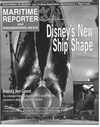
Page 13: of Maritime Reporter Magazine (March 1998)
Read this page in Pdf, Flash or Html5 edition of March 1998 Maritime Reporter Magazine
MARINE FINANCE
Forest Products Nicho Looks Ripo For Expansion 12% growth predicted over six years; Ports must step up improvement efforts
In its latest report — Forest
Products Shipping: Looking to the
Upturn? — London's Drewry
Shipping Consultants forecast that the forest products trade will rise, in terms of tonnage, nearly 12 per- cent by the year 2004 from current levels of around 170 to 175 million tons/year.
As significant to the shipping communities as are the hard num- bers, so too are the changes in the type of products to be shipped and service expected.
Trade growth, according to
Drewry, will not be distributed evenly: The focus will be on "down- stream" products such as sawn- woods and boards/panels rather than logs and pulp and paper prod- ucts rather than pulp wood. This will be crucial for both ship opera- tors and ports as they will see more business falling into the dual are- nas of minimum/nil damage "cargo care" and just-in-time (JIT) deliv- ery.
Holding A Steady Course
While not a major focus of the shipping market in general, the carriage of forest products has enjoyed steady growth over the last decade.
Tonnage transported in the mid- 1980s equaled 125 to 130 million tons/year; this compares with 150 to 155 million tons/year at the start of the 1990s. In its latest report, Drewry estimated that by 2004 total seaborne trade could be touching approximately 190 mil- lion tons.
Even if trade volumes stall in the short term, key underlying funda- mentals that underpin forest prod- ucts demand — population growth, improving living standards (increasing demands generated by existing populations) and increas- ing levels of literacy — are wholly growth oriented.
The forest products trades make use of virtually every type of dry cargoship, with success deter- mined by the blend of logistics, competitive advantage, quality of service and freight rates. This cre- ates various shipping "battle- grounds" where competition comes to a head. Such an arena is the
North American export sector.
Late 1997/early 1998 have seen a good deal of tension arise as vari- ous contract renewal sessions have come around. Drewry noted that this tension is not wholly about freight rates (though this is impor- tant) as the business has other logistical elements. Generally speaking, the breakbulk sector regards the container market as a threat. With crisis in Asia impact- ing on the demand, not just for for-
R.W. FERNSTRUM & COMPANY 50 YEARS EXPERIENCE IN ENGINEERED KEEL COOLING
You want the best of everything on your boat, as long as it's affordable...right?
Then why don't you give us a call? For the cost of a phone call, well figure out which of over 8000 different Gridcoolers is right for cooling your engine in your application.
How can you go wrong? We've been engineering cooling systems for all types of marine engines for the last 50 years. Our product is so durable, efficient and easy to install that the U.S. Navy wrote their keel cooling specifications around our Gridcoolers.
Why take chances when it comes to your engines' dependability?
Do it right the first time... use Fernstrum Gridcoolers. • Completely assembled and factory tested • Silver brazed and welded joints • Heavy gauge 90/10 copper-nickel or 5000 series aluminum rectangular tube • Custom designed • The most compact form of keel cooling und only in the
GRIDCOOLER: 1716 11th Avenue, Menominee, Ml 49858
Ph: 306-863-5553 Fax: 306-863-5634
March, 1998 Circle 271 on Reader Service Card 13

 12
12

 14
14
